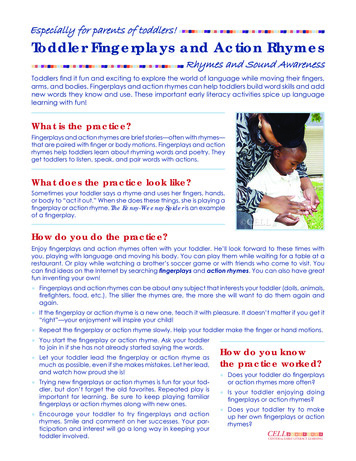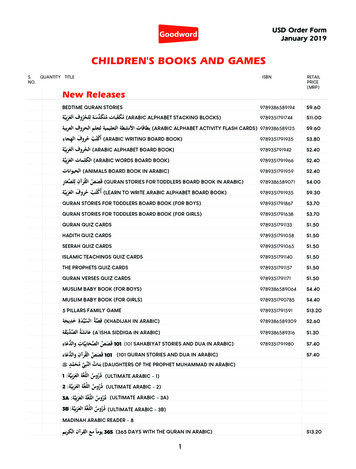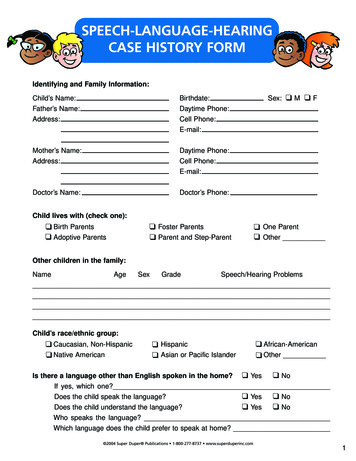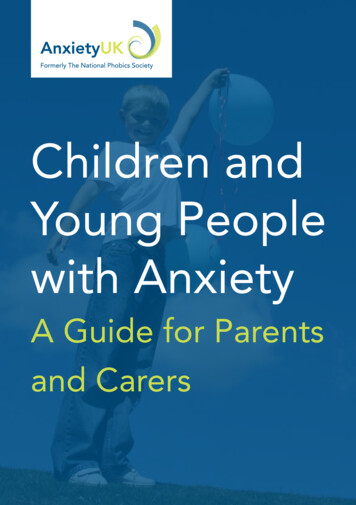
Transcription
Especially for parents of toddlers!Toddler Fingerplays and Action RhymesRhymes and Sound AwarenessToddlers find it fun and exciting to explore the world of language while moving their fingers,arms, and bodies. Fingerplays and action rhymes can help toddlers build word skills and addnew words they know and use. These important early literacy activities spice up languagelearning with fun!What is the practice?Fingerplays and action rhymes are brief stories—often with rhymes—that are paired with finger or body motions. Fingerplays and actionrhymes help toddlers learn about rhyming words and poetry. Theyget toddlers to listen, speak, and pair words with actions.What does the practice look like?Sometimes your toddler says a rhyme and uses her fingers, hands,or body to “act it out.” When she does these things, she is playing afingerplay or action rhyme. The Eensy-Weensy Spider is an exampleof a fingerplay. CELLHow do you do the practice?Enjoy fingerplays and action rhymes often with your toddler. He’ll look forward to these times withyou, playing with language and moving his body. You can play them while waiting for a table at arestaurant. Or play while watching a brother’s soccer game or with friends who come to visit. Youcan find ideas on the Internet by searching fingerplays and action rhymes. You can also have greatfun inventing your own! Fingerplays and action rhymes can be about any subject that interests your toddler (dolls, animals,firefighters, food, etc.). The sillier the rhymes are, the more she will want to do them again andagain. If the fingerplay or action rhyme is a new one, teach it with pleasure. It doesn’t matter if you get it“right”—your enjoyment will inspire your child! Repeat the fingerplay or action rhyme slowly. Help your toddler make the finger or hand motions. You start the fingerplay or action rhyme. Ask your toddlerto join in if she has not already started saying the words. Let your toddler lead the fingerplay or action rhyme asmuch as possible, even if she makes mistakes. Let her lead,and watch how proud she is! Trying new fingerplays or action rhymes is fun for your toddler, but don’t forget the old favorites. Repeated play isimportant for learning. Be sure to keep playing familiarfingerplays or action rhymes along with new ones. Encourage your toddler to try fingerplays and actionrhymes. Smile and comment on her successes. Your participation and interest will go a long way in keeping yourtoddler involved.How do you knowthe practice worked? Does your toddler do fingerplaysor action rhymes more often? Is your toddler enjoying doingfingerplays or action rhymes? Does your toddler try to makeup her own fingerplays or actionrhymes?CELL p ra c t i c e sCENTER for EARLY LITERACY LEARNING
More introducing fingerplays and action rhymesEensy-Weensy SpiderAt 18 months, Sophia had never done a fingerplay.Knowing that Sophia was always waving her arms, Momdecided to teach one. As Sophia waved her arms, Momtook her into her lap. She snuggled Sophia and placedher arm around her. Mom began to sing Eensy-WeensySpider and move Sophia’s hands to make the motions.After she finished, she waited to see Sophia’s reaction;Sophia smiled up at her mom and moved her arms. Mombegan the song again, doing the motions with Sophia’shands. By the third time through, Sophia was trying to dothe motions on her own. She showed clearly how muchshe enjoyed it and wanted to continue playing.Action-Rhyme ‘Rowing’Maya, 23 months of age, is a powerhouse of energy. Maya’smom decided doing an action rhyme like Row, Row, RowYour Boat would be something “Miss Energy” would enjoy.She asked Maya to sit facing her, on her lap, so that theycould hold hands. Mom showed Maya how to lean forwardas she pulled Maya forward. How to lean back and pull hermom toward her. They did the motion a few times. Then Maya’s mom began to sing Row, Row, Row Your Boat in timeto their rocking. When they finished, Maya wanted to do itagain and again!‘There was a little turtle.’Kara is a toddler who has a hard time sitting still whilelistening to books or songs. Her mom knows how muchKara loves her pet turtle. She finds a fingerplay abouta turtle on the Internet (There Was a Little Turtle WhoLived in a Box). She recites it to Kara every day whileKara feeds or plays with her pet. She even changes thewords to include the turtle’s name. Once Kara is familiar with the rhyme, she begins trying the motions. Karaloves pretending to “snap” at fleas and mosquitoes withher fingers. Soon she can recite the rhyme. Along withher mom, she does the motions. Sometimes she evenstresses the rhyming words at the end of each line!CELLpractices Is a publication of the Center for Early Literacy Learning (CELL), funded by the U.S. Department of Education, Office of SpecialEducation Programs (H326B060010). The opinions expressed, however, are those of CELL and not necessarily those of the U.S. Department ofEducation. Copyright 2010 by the Orelena Hawks Puckett Institute, Asheville, North Carolina (www.puckett.org).
Especially for parents of toddlers!Movin’ and Groovin’ Nursery RhymesRhymes and Sound AwarenessExploring the world of language while getting to move their bodies is exciting for most toddlers.Action rhymes—rhymes paired with body movements—are fun. They give toddlers opportunitiesto learn new words and phrases while matching them with physical movements.What is the practice?The chants and body movements of action rhymes promote thedevelopment of speech and listening skills. Young toddlers oftenengage in action rhymes with a parent or other children.What does the practice look like?Action rhymes are short rhymes—either sung or spoken—that arematched with body movement to tell a story. An example of anaction rhyme is Ring Around the Rosies. Walking in a circle with bigbrother and sister and falling down at “We all fall down” is greatfun. You can find action rhymes that help toddlers build word skillsby searching the Web. A good term to search is action rhymes. Tohelp you make up your own action rhymes, search with the term rhyming words for fun ideas.How do you do the practice?The practice guide Fingerplays All the Way offers some suggestions about how to introduce actionrhymes to your toddler. Using action rhymes about topics of interest to your child is an importantstarting point. The following are a few examples of action rhymes your toddler might enjoy:Little, Bigger, BiggestA little ball, (Make a ball with finger and thumb.)A bigger ball, (Make a ball with two hands.)And a great big ball. (Make a ball with arms.)Now help me count them.One, Two, Three! (Repeat gestures for each size.)Ring Around the RosiesRing around the rosies.A pocket full of posies. (Hold hands and go aroundin a circle for the first two lines.)Ashes, ashes, we all fall down! (Fall to theground.)Row Your BoatRow, row, row your boatGently down the stream.Merrily, Merrily, Merrily, Merrily,Life is but a dream.(Sitting on the floor with your child, hold his or herhands and rock backward and forward.)StretchingWhen I stretch up, I feel so tall. (Reach high.)When I bend down, I feel so small. (Bend over.)Taller, Taller, Taller, Taller. (Reach up high.)Smaller, Smaller, Smaller, Smaller.(Get low on the floor.)Into a tiny ball.How do you knowthe practice worked? Does your toddler participate more in action rhymes? Is your toddler smiling and laughing whiledoing the action rhyme? Does your toddler try to change or makeup new action rhymes?CELL p ra c t i c e sCENTER for EARLY LITERACY LEARNING
Take a look at more action rhymes for toddlersFun with RhymingTwo-year-old Sadie always enjoys jumping and running around,so action rhymes are fun for her. She and her dad do the motionstogether and take turns being the leader. Dad starts with “Standup tall” and they both stretch up high. “Get down small” and theydrop to the floor in a ball. Then Sadie takes a turn and calls, “Runto the hall!” They both take off running to the hall. The back-andforth directions continue with words rhyming with ball, like call, hall,small, tall, fall, crawl, and wall. Sadie loves playing the game andbegins to make up nonsense words that rhyme.Calming Action RhymesSometimes going to bed isn’t easy. Peter’s dad hasfound that calming action rhymes help his 30-monthold toddler settle down. Dad makes up a rhyme forbed time. Dad says, “Time for bed, time for bed,” andPeter crawls onto the bed. “Fluff up your pillow,” and hepushes on his pillow. “Lay down your head,” and downgoes the head. “Pull up the blanket,” he pulls up thecover. “Tuck in tight,” Dad makes sure the covers areup. “Close your eyes and sleep all night!” Dad knowsPeter enjoys the rhymes, actions, and settling effect ofthe routine because he asks for it every night.It’s a Stretch!Raza, a toddler with moderate motor impairment,loves to sing and dance to his favorite children’ssongs. When “Heads, Shoulders, Knees and Toes”starts, Raza loves the rhymes and trys to touch thecorrect body parts. Big brother Sahil stands behindhim and helps move Raza’s arms to touch the rightparts at the right time. Sometimes they both get lostgoing too fast, which makes them laugh. SometimesSahil tries to get Raza to do the motions wrong, andhe cheers when Raza catches the mistake. Theyboth sing the song, and Raza moves more easily ashis muscles strengthen and stretch.CELLpractices Is a publication of the Center for Early Literacy Learning (CELL), funded by the U.S. Department of Education, Office of SpecialEducation Programs (H326B060010). The opinions expressed, however, are those of CELL and not necessarily those of the U.S. Department ofEducation. Copyright 2010 by the Orelena Hawks Puckett Institute, Asheville, North Carolina (www.puckett.org).
Especially for parents of toddlers!Toddler Rhymes and RhythmRhymes and Sound AwarenessNursery rhymes help toddlers become aware of the rhythms and rhymes of language. Using old rhymes and new rhymes you invent helps your toddler become familiar with thesounds of letters and words.What is the practice?This guide includes rhyming activities to help toddlers learn to focus on sounds. Such activities help toddlers learn that the changeof one letter sound creates a rhyming word with a new meaning.For example, cat to hat. Combining rhyming words to make a sillypoem is a fun activity for toddlers.What does the practice look like?Children learn how sounds and words are connected when theyhear words with identical or similar endings repeated in rhymes.Simple rhymes created for young children are often called nursery rhymes. “Hickory, dickory dock / A mouse ran up the clock .”is an example of a well-known nursery rhyme. CELLHow do you do the practice?Everyday life presents different opportunities for playing rhyming games. Repeating, singing, ormaking up rhymes can become part of many ordinary routines. You can search the Internet fornursery rhymes or rhymes for toddlers. You can find children’s nursery rhyme books at the library.There are many fun poems about everyday activities (bath time, working in the garden) andoccasions (birthdays and holidays). Identify rhymes about things your toddler is interested in or enjoys. For example, if your childlikes animals, “Hey diddle diddle, the cat and the fiddle ” might be a good choice. The moreyour child enjoys the content of the rhyme, the more likely she will say the rhyme with you. Rhymes can happen anywhere. You can make them up as you walk down the street. Forexample, “Step one, step two, look at my shoe.” You and your toddler can repeat rhymesduring daily activities. For example, try “Rub a dub,dub, three men in a tub” during baths. Don’t worry about getting the rhymes “right.” Youngchildren simply enjoy the sounds they are making.The sillier the rhymes are the better! As your toddler gets used to saying rhymes with you,let her pick or start the next rhyme. Let your child makeup a rhyme all alone or with a little help from you. Remember, it is the fun of rhyming that motivates herto continue rhyming, not whether the rhyme makessense. Praise your toddler’s efforts to say rhymes with you andto make up rhymes.How do you knowthe practice worked? Is your toddler saying rhymeswith you? Does your toddler smile or laughwhen rhyming? Does your toddler want to makeup new rhymes?CELL p ra c t i c e sCENTER for EARLY LITERACY LEARNING
Take a look at more rhymes and rhythmWalkin’ and Rhymin’Taking a walk through the mall with his mom is one of27-month-old Damian’s favorite activities. While walkingalong, his mom often begins a silly rhyme: “One, two,buckle my shoe.” Damian repeats it while looking up andsmiling at his mom. Now his mom says, “One, two, bucklemy shoe; three, four, close the door.” Damian repeats thetwo lines. They add lines, “Five, six, pick up sticks. Seven,eight, lay them straight. Nine, ten, a big fat hen.” Damiansings out the words in unison with his mom. CELLRub-a-dub-dub!Taking a bath is something 22-month-old Anna enjoys. But sometimes it is hard to stop playing with herfavorite toys and get in the tub. Anna’s dad helpsby using a silly rhyme to let her know it is time for abath. Dad says, “Rub-a-dub-dub, three friends in atub, and who do you think they be? Anna, the baker,and the candlestick maker, put them in all three!”He scoops up Anna and off they go together singingand laughing “Rub-a-dub-dub.”Rhythmic LearningRhyming is also about rhythm. Dylan, a 2-year-old, has moderate hearing loss. Dylan’s mom uses her favorite rhymes, adding movement to help him feel the rhythm. Dylan loves therhymes when his mom rocks him back and forth to the rhythm.He likes his mom to help him clap the rhythm as they chanttheir favorite rhymes.CELLpractices Is a publication of the Center for Early Literacy Learning (CELL), funded by the U.S. Department of Education, Office of SpecialEducation Programs (H326B060010). The opinions expressed, however, are those of CELL and not necessarily those of the U.S. Department ofEducation. Copyright 2010 by the Orelena Hawks Puckett Institute, Asheville, North Carolina (www.puckett.org).
Especially for parents of toddlers!Fingerplays All the WayRhymes and Sound AwarenessExploring the world of language is fun when fingerplays are a toddler’s learning tools. Fingerplayslet young children enjoy exploring language in ways that build word skills and use new words.Both are important early literacy skills.What is the practice?Fingerplays are very brief stories—often with rhymes—that use finger movements to help tell the story.Fingerplays introduce rhyming and poetry to young children. They provide fun opportunities to listen andspeak. And they encourage children to match words with physical actions.What does the practice look like?When your toddler recites or sings rhymes and uses her fingers or hands to “act it out,” she’s doing fingerplays. Singing and doing the motions to Eensy-Weensy Spider is an example of a fingerplay. You can findmany fun fingerplays by searching on the Web for fingerplays or preschool fingerplays. Librarians can helpyou borrow good books of fingerplays, lap games, and other fun literacy activities for toddlers.How do you do the practice?Enjoy fingerplays again and again, offering your toddler the opportunity to have fun playing with wordsand body movements. Do fingerplays together while you’re waiting in the grocery line, preparing for bed,or watching a big sister’s soccer practice. Fingerplays give a squirming toddler the opportunity to become“active” while he needs to sit and wait. Fingerplays and action rhymes can be about any subject that interests your toddler (animals, trucks,food, and more). The sillier and more fun they are, the more your toddler will enjoy trying to say them. If the fingerplay is new to your toddler, teach it with excitement.It doesn’t matter if you get it “right.” Your interest will captureyour toddler’s attention.Bunny PuppetHere is a bunny, with ears so funny, (Raise two fingers.)And here is a hole in the ground. (Make hole with other hand.)At the first sound she hears, she pricks up her ears, (Straightenfingers.)And pops right into the ground. (Put fingers in hole.)HomesA nest is a home for a bird. (Cup hands to form a nest.)A hive is a home for a bee. (Turn cupped hands over.)A hole is a home for a rabbit. (Make a hole with hands.)And a house is a home for me. (Make roof with peaked hands.)How do you knowthe practice worked?Where Is Thumbkin? Does your toddler do fingerplays or(Start with hands behind back.)action rhymes more often?Where is Thumbkin? Where is Thumbkin? Is your toddler enjoying the fingerHere I am. (Bring right hand to front, with thumb up.)plays or action rhymes?Here I am. (Bring left hand to front, with thumb up.)How are you this morning? Does your toddler try to make up hisVery well, I thank you. (Wiggle thumbs as if they’re ‘talking’ together.)own fingerplays or action rhymes?Run away. (Hide right hand behind back.)Run away. (Hide left hand behind back.)CELL p r a c t i c e s(Repeat rhyme with each finger: Pointer, Tall Man, Ring Man, and Pinkie.)CENTER for EARLY LITERACY LEARNING
Take a look at more fun with fingerplaysIn MotionWaiting in a store check-out line with a2-year-old can be hard. Lewis’s mom usesa fingerplay to keep her son from gettingrestless. Since Lewis likes rhymes, Mom startsplaying Bunny Puppet. Lewis quickly joins insaying the words and trying to straightenout his fingers for the rabbit’s ears. Momhelps with the motions, but since Lewisknows all the words, she doesn’t say them.Mom knows Lewis enjoys this because,while Mom is paying for the groceries,Lewis is still doing the fingerplay. CELLWhere Is Thumbkin?Many evenings, 2½-year-old Vincent and his momspend time together playing in the family room.Sometimes they read a book or talk about whothey saw during the day. Vincent always wantsto do fingerplays. He loves their special versionof Where Is Thumbkin? They each hide just onehand. They sing, “Where is Thumbkin? Where isThumbkin?” followed by “Here I am! Here I am!”They each bring out their hand and wave theirthumbs at each other. Vincent giggles with delightas they finish the rhyme. CELLI Can Do It, Too!It’s hard for John to get his fingers to do all themotions for fingerplays. But he likes to try. John’smom simplifies the finger motions. For example, inEensy-Weensy Spider, he can’t touch each fingertogether. John and his mom just touch their handstogether as they raise their arms. They bring downtheir arms when they say, “Down came the rain.”They swing their arms in front of them when they say“and washed the spider out.” With “Out came thesun and dried up all the rain,” they lift their curvedarms high. Again, they touch their hands together asthey repeat, “The eensy-weensy spider climbed upthe spout again!”CELLpractices Is a publication of the Center for Early Literacy Learning (CELL), funded by the U.S. Department of Education, Office of SpecialEducation Programs (H326B060010). The opinions expressed, however, are those of CELL and not necessarily those of the U.S. Department ofEducation. Copyright 2010 by the Orelena Hawks Puckett Institute, Asheville, North Carolina (www.puckett.org).
Especially for parents of toddlers!Sound PlayRhymes and Sound AwarenessToddlers are beginning to discover the many uses of language. They are beginning to explorewhat words get responses from people around them. Helping toddlers develop their language skillsby joining their verbal play increases awareness of sounds and encourages them to speak.What is the practice?Most toddlers naturally play with language by repeating words, phrases, or songs over and over. They like tomake up nonsense words. You can help your toddler’slanguage develop by joining in his play. Encourage himto pay attention to the sounds he is making. Researchshows when caregivers respond enthusiastically to attempts at word play, toddlers develop language skillsmore quickly and easily.What does the practice look like?Toddlers like asking ‘why’ questions, singing TV-show songs, or making up names for favorite stuffed animals. These are all examples of toddlers playing with language. As a parent, you can join in by answeringquestions and asking some of your own. You can sing along, and you can point out which silly-soundingnames rhyme or sound alike.How do you do the practice?There are many daily opportunities for you to encourage your toddler’s verbal play. Follow your child’slead with anything she wants to ‘talk’ about. Join your child in singing familiar songs from books, TV, movies, or day care. Encourage your child totry making up different words. Use your child’s name or the names of friends or pets to make up newwords. Introduce your toddler to the idea of rhyming by reading and reciting nursery rhymes with her. Encourage her to listen to the sounds. These are good to recite and play with while driving in the car. Youcan use the sights around you (cars, favorite stores, people walking, trees) to think of other words torhyme. Play games about the sounds things make,asking “What does the cow say?” or “Whatdoes that truck say?” Encourage your child touse his imagination to think about the way thingssound. For example, a toddler might think a verylarge truck would make a deep, loud sound. Hemight think a spider would make a much smallersound. These games help your child get used topaying attention to sounds in words and soundsthat aren’t words. Have fun! Learning to talk is a complicatedprocess, and children develop all the skills overtime in their own ways. Being silly with your childas he begins to play with words and soundsincreases his interest in language.How do you knowthe practice worked? Does your child try to engage you and othersin conversation or word play? Is your child eager to sing along with you, andwith familiar songs on the radio or TV? Is your child showing more understanding ofhow people communicate with words?CELL p ra c t i c e sCENTER for EARLY LITERACY LEARNING
Take a look at more verbal play with toddlersSongs on the Go!Nora, 2½ years old, is in her car seat on the way to the storewith her dad. She is singing and talking to herself abouteverything they pass. “Sing Old McDonald, Daddy,” shesays. “Okay, you help me,” Dad responds, and starts tosing. Then he pauses and asks, “What animal first?” “Cow!”Nora says, and chimes in on the mooing and other animalsounds. When they run out of animal ideas, her dad adds averse: “.and on that farm they had a—Nora! What woulda Nora say?” She laughs and calls out, “Ice cream!” “Okay,let’s sing that,” Dad says. They sing verses with the namesof friends and family members. Nora supplies the words orsounds she thinks they would say. This lets her practice usinga range of sounds, words, and expressions.Rhyme TimeTwo-year-old Milo and his mom are together feedinganimals in their barn. Touching the wooly head of a lamb,Milo says, “Lamb!” “That’s right,” his mom says. “This is ournew lamb. Can you think of other words that sound likelamb?” Milo hesitates. “Think of your favorite book,” hismom suggests. “Green Eggs and .” “Ham!” Milo says.“Right! Hear how they sound the same? Lamb and ham.”“Lamb, ham, fam, bam ” Milo says. “They all soundthe same,” his mom says. “How about ram, like a daddysheep?” They take turns coming up with more rhymingwords. Milo’s mom isn’t worried that some of the soundsaren’t real words. Milo is practicing how to play with anduse sounds, and the more comfortable he gets with thisthe more words he will learn.Loud/Soft, Fast/SlowJohn, a toddler with Down syndrome, is seated on his dad’slap, pretending to drive the family car. “Here we go,” his dadsays, “Vroom There’s a truck. What do we say to Mr. Truck?”“Vroom, vroom” John says, holding on to the steering wheel.“What? Mr. Truck can’t hear you,” says Dad. “Can you say thatlouder?” “Vroom!” John makes his car yell. “Oops, too loud. Canyou do it softer?” Dad whispers. John whispers, “Vroom.” Theyplay with the sounds of the car, trying out louder and softer.They make fast sounds—pretending they’re race car drivers.They make slow sounds for heading up a hill. This play allowsJohn to practice using his voice and sounds, and using wordsby speaking for his car. CELLCELLpractices Is a publication of the Center for Early Literacy Learning (CELL), funded by the U.S. Department of Education, Office of SpecialEducation Programs (H326B060010). The opinions expressed, however, are those of CELL and not necessarily those of the U.S. Department ofEducation. Copyright 2010 by the Orelena Hawks Puckett Institute, Asheville, North Carolina (www.puckett.org).
Especially for parents of toddlers!Fun and Games with SoundsRhymes and Sound AwarenessOne skill a child needs to read is an understanding of how sounds go together to formwords. This guide includes early word games that help toddlers see how sounds formwords. This is an important building block for later reading.What is the practice?Help toddlers develop an early understanding of how sounds gotogether to form words by playing sound and word games. Thesefun activities help toddlers see the connections between varioussounds and the words they can make.What does the practice look like?Playing with sounds (ma-ma and da-da) to make “new” words orsilly sounds is fun. It also helps your toddler understand that lettersrepresent different sounds that can be combined into words. Your toddler learns that thesesounds can be put together in various ways to create new words. It’s an important early steptoward reading.How do you do the practice?Opportunities to learn about sounds in words occur during ordinary activities like changing clothesor taking a bath. Think about the things your child likes to say and do. Often young children have a word orsound that they say again and again just because it’s fun. For example, some toddlers loveto make animal sounds such as baa, meow, or woof. Other children may like to make upsilly names for their pets, dolls, or family members. Catch your toddler’s attention by repeating the sounds he likes to say. Then change the first letter to make a new silly word: Baa-baabecomes la-la. Word play can happen on the spur of the moment as part of your toddler’s everyday routines.For example, if while taking a bath or riding in the car your toddler begins to make a sound,you can repeat the sound. Encourage him to say it back to you. When it’s your turn, changethe sound a little bit. Then ask your toddler if hecan say it too. Encourage your toddler to repeatHow do you knowthe sound you made or say a new one. Show yourthe practice worked?enjoyment as the game continues. Is your toddler starting to “play” withAs your toddler’s speech strengthens, begin to putindividual sounds or words?words together in short sentences with the same sound. For example, “Did the doggie dig?” Laughabout the funny sound of “doggie dig” and askyour toddler to repeat the phrase. Does your toddler seem pleasedwhen he is trying to make or copyyour sounds?Show your toddler that he did well by smiling andcommenting on his efforts. A little encouragementwill keep your toddler playing the game longer.Be sure you stop when he tires of the game. Has your toddler shown interest intrying new sounds and words?CELL p ra c t i c e sCENTER for EARLY LITERACY LEARNING
Take a look at more fun with soundWord Fun on WheelsRiding in a car is often a great opportunity forMaya and her mother to play word games.While riding along, 18-month-old Maya beginsmaking sounds like ba-ba-ba. Her mom, following Maya’s lead, repeats Maya’s ba-ba-ba andadds her own pa-pa-pa. She asks Maya if shecan say ba-ba-ba and pa-pa-pa. Maya lovesplaying ba-ba-ba and will repeat the soundsto get her mom to do it some more.Rhyming GameNathan’s dad plays a word game with him that includes lotsof movement. Nathan, a 28-month-old, loves to move. Theycall their game Drop/Hop. First, Nathan’s dad teaches himto hop up and down when he says “Hop.” He shows Nathanhow to drop to the floor when he says “Drop.” He teacheshim to put his hand on his head when he says “Top.” Finally,he shows him to clap his hands when he says “Pop.” Whenthey play their Drop/Hop game, Nathan’s dad asks whoshould be the leader first. Nathan usually wants to be first.He tells his dad to drop and they both fall on the ground.Then his dad tells him to hop and they do. They continueto play back and forth until they both get tired.Word and Sound PlayJenna, a toddler with a mild hearing impairment, loves toplay with her dad while swinging in the park. Her dad picksa word Jenna can say. He says it in different ways: loud, soft,slow (stretching the sounds out), fast (saying the syllablesquickly), and singing. Each time, Jenna repeats the word thesame way her dad said it. Often Jenna will say another word.They play with that word the same way, with Jenna takingthe lead. Jenna loves the word game on the swing, and ithelps her listen to the difference between sounds.CELLpractices Is a publication of the Center for Early Literacy Learning (CELL), funded by the U.S. Department of Education, Office of SpecialEducation Programs (H326B060010). The opinions expressed, however, are those of CELL and not necessarily those of the U.S. Department ofEducation. Copyright 2010 by the Orelena Hawks Puckett Institute, Asheville, North Carolina (www.puckett.org).
More introducing fingerplays and action rhymes Eensy-Weensy Spider Action-Rhyme ‘Rowing’ ‘There was a little turt










